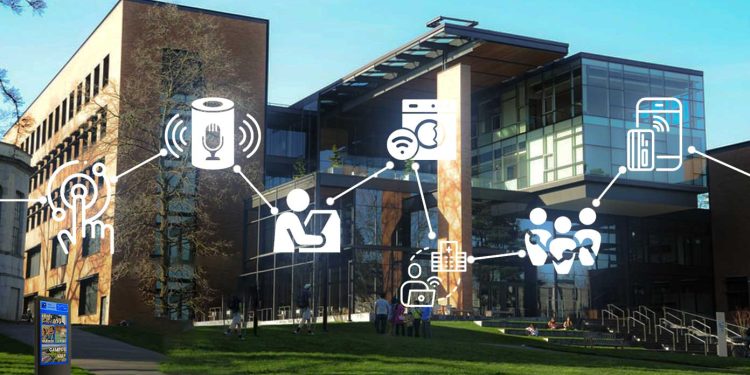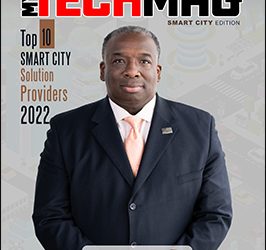The notion of building a smart campus has become popular among school administrators as they aim to create a secure and efficient educational experience for students.
As per a recent study of higher education authorities, 43% believe smart campus infrastructure may help students stay in college longer. Half of the higher education executives polled believed a well-planned smart campus idea would lead to considerable cost savings.
As institutions respond to their students’ requirements, they may implement a smart campus plan that encourages efficient behaviors. Higher education institutions should focus on best practices that will set them apart as part of the smart campus concept, rather than a transactional process change.
What Does a Smart Campus Mean?
A smart campus offers a beneficial interactive experience by utilizing modern communications infrastructure and web-connected gadgets. It connects people, resources, and apps, allowing institutions to make data-driven choices to ensure safety and increase revenue.
Gartner rated smart campus technology among the top ten strategic technologies influencing higher education. To support the smart campus idea, universities mix network equipment and devices. Administrators can fulfill smart campus plan goals by identifying needs while managing finances using the fundamental framework.
Below are some of the use cases of smart campuses:
- Direct guests to available parking spots and give mapping technology for the site
- Identify leaky pipes or malfunctioning appliances before they become a problem
- Data may be used to find possibilities to reassign people to more meaningful positions
- Offer interaction tools and self-service technology to contribute positively to classroom education
- Improve productivity while retaining a human-centric strategy by automating student and teacher activities
Features of a Smart Campus
The contribution of a smart campus in raising the standard of living of its members is becoming a key element in its architecture. The necessity of interconnection and the advantages it delivers are a recurring theme in all designs. Given below are a few of its crucial features:
Easy-to-Use
Like other higher learning constituencies, today’s students are tech-savvy and want to engage with a simple platform to use. The solution should provide a fantastic and easy-to-use user experience. Identities, usability testing, primary use cases, and consumer experience when engaging with an intelligent management system will provide true intelligence and utility for smart campuses.
Persona-Centric Design Thinking
Touchless communication with the system ought to be possible through various interfaces, including video, speech, gesture, and contact. The framework should tackle who must be served and how they should be served. Smart Campuses achieves this goal and offers a seamless user experience.
Modular, Adaptable, and Versatile
Campus demands and the systems that support them are constantly changing. At its finest, the solution isn’t bound by a collection of technologies or core competencies created just for the first day. A smart campus technology can solve this problem by utilizing a domain-driven conceptual framework based on modules that facilitate campus modernization.
These modules are self-contained, interchangeable functionality elements. The objective is to design loosely connected software applications and services that exploit previously built capabilities and technologies. This architectural pattern enables the transformation of operations, allowing the smart campus to grow significantly and allowing functionalities to be utilized in any way.
As a result, systems may be created in a way that meets the ever-changing demands of end consumers.
Scalable
The technology is meant to allow schools and institutions to work with peers while also scaling tremendously. While higher academic institutions are small and local in scope, smart campus technology should provide for global expansion to achieve the institution’s objectives.
The solution makes use of modern tools and technology to deliver data-driven insights while also allowing to reach and scale. The solution may be created to serve students, whether they are in a classroom setting on-site or in an online virtual classroom.
Also read: Technology in Higher Education
Benefits of a Smart Campus
A smart campus uses networked technology to improve cooperation, resource efficiency, security, cost savings, and render the institution more integrated and pleasurable. Institutions may use a smart campus to integrate systems like lighting, gadgets, cameras, and many more to provide students with streamlined and connected experiences.
1. Enhances the Learning Experience
Students demand homelike internet connectivity in all areas of the school. Colleges must deliver modern classroom settings that are easy, safe, and tailored to serve students.
In addition, accessibility is crucial. Students should travel freely throughout the campus and count on intuitive, accessible, and simple services to use.
As the year 2020 has demonstrated, on-campus settings must adapt swiftly to accommodate the requirements of off-campus pupils. Universities must provide identical experiences regardless of whether the lesson is remote or online to accomplish this.
2. Improves Security
Although crimes at undergraduate schools have decreased over the past twenty years, campus security remains a concern. Good illumination and security patrols are not sufficient to provide kids’ protection.
Students and their families can have a sense of peace due to internet-connected security functions. Smart campus technology assists in the reduction of crime while also raising awareness. Universities may implement intelligent technology to secure assets and individuals using dependable linked systems.
3. Elevates the University’s Credibility
Every aspect of a smart campus improves its reputation. Thanks to enhanced security features, proactive academic support services, and new pedagogical methodologies, an institution can have a competitive edge.
Furthermore, a university can effortlessly gather user-generated material for advertising and outreach with always-connected pupils.
Summing Up
Data from many building applications may be aggregated and consolidated by integrating previously independent systems into a central hub. This simplified method enables institutions to evaluate data more readily.
Furthermore, it assists administrators in making data-driven decisions that increase operational efficiency and intelligence. While the integration of networks may appear complicated, achieving connection is easier than many people believe.








